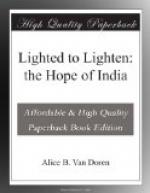School Life.
It is not unusual for an Indian girl to spend ten or twelve years in such a boarding school. An institution is a poor substitute for a home, but in such cases it must do its best to combine the two. This means that books are almost accessories; school life is the most vital part of education.
To such efforts the Indian girl responds almost incredibly. Whatever her faults—and she has many—she is never bored. Her own background is so narrow that school opens to her a new world of surprise. “Isn’t it wonderful!” is the constant reaction to the commonplaces of science. No less wonderful to her is the liberty of thinking and acting for herself that self-government brings.
Seeta loves her home, but before a month is over its close confinement palls and she writes back, “I am living like a Muhammadan woman. I wish it were the last day of vacation.” Her father is shocked by her desire to be up and doing. He calls on the school principal and complains, “I don’t know what to make of my daughter. Why is she not like her mother? Are not cooking and sewing enough for any woman? Why has she these strange ideas about doing all sorts of things that her mother never wanted to do?” Then the principal tries to explain patiently that new wine cannot be kept in old bottles, and that unless the daughter were to he different from the mother it was hardly worth while to send her for secondary education. So, when the long holiday is over, Seeta returns with a fresh appreciation of what education means in her life; and we know that when her daughters come home for vacation, it will be to a mother with sympathy and understanding.
The girls’ loyalty to their school is at times almost pathetic. An American teacher writes, “One moonlight night when I was walking about the grounds talking with some of the oldest girls, one of them caught my hand, and turned me about toward the school, which, even under the magic of the Indian moon, did not seem a particularly beautiful sight to me. ‘Amma’ (mother), she said, in a voice quivering with emotion, ’See how beautiful our school is! When I stand out here at night and look at it through the trees, it gives me such a feeling here,’ and she pressed her hand over her heart.
“‘Do you think it is only beautiful at night?’ one of the other girls asked indignantly, and all joined in enthusiastic affirmations of its attractions even at high noon,—which all goes to show how relative the matter is. I, with my background of Wellesley lawns and architecture, find our school a hopelessly unsanitary makeshift to be endured patiently for a few years longer, but to these girls with their background of wretchedly poor village homes it is in its bare cleanliness, as well as in its associations, a veritable place of ‘sweetness and light.’”
Athletics.




